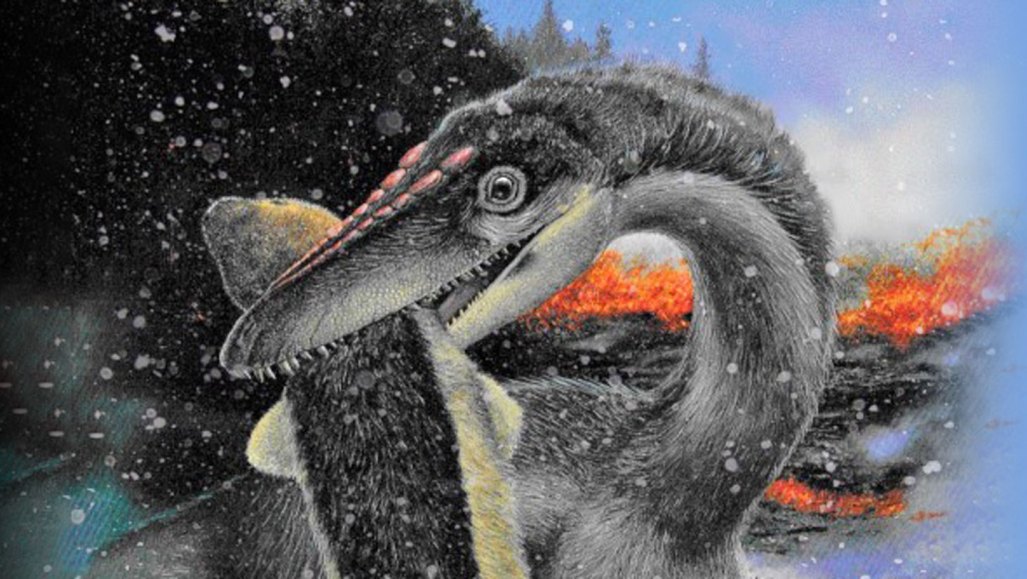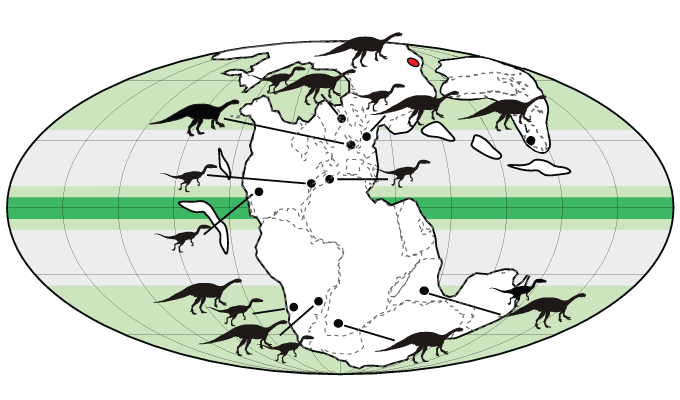Feathers may have helped dinosaurs survive the Triassic mass extinction
Volcanic winters set off by massive eruptions may have spelled doom for many uninsulated reptiles

A feathered theropod dinosaur snags a mammal snack amid a snowy winter caused by massive volcanic eruptions about 202 million years ago in this artist’s rendition.
Painting by Larry Felder
- More than 2 years ago
Read another version of this article at Science News Explores
Widespread volcanic eruptions around 202 million years ago had a profound effect on Earth’s climate, triggering a mass extinction event that killed off three-fourths of the planet’s species, including many large reptiles. Yet dinosaurs, somehow, survived and went on to thrive.
Dinosaurs are often thought of as heat-loving, well suited to the steamy greenhouse environment of the Triassic Period. But the secret to their survival may have been how well adapted they were to the cold, unlike other reptiles of the time. The dinosaurs’ warm coats of feathers could have helped the creatures weather relatively brief but intense bouts of volcanic winter associated with the massive eruptions, researchers report July 1 in Science Advances.
“We’ve known for a while that there were probably volcanic winters” associated with the massive eruptions, says paleontologist Paul Olsen of the Lamont-Doherty Earth Observatory at Columbia University. Along with carbon dioxide, volcanoes spew sulfur particles into the atmosphere that can darken skies for years and lower global temperatures — as the Philippines’ Mount Pinatubo did after its powerful 1991 eruption (SN: 8/8/18). “But how [such winters] fit into the picture of the end-Triassic mass extinction has been very unclear.”
In the new study, Olsen and his colleagues present the first physical evidence that not only did such winters occur at the end of the Triassic, but also that dinosaurs were there to weather them. At a site called the Junggar Basin, which at the close of the Triassic was found high in the Arctic Circle, the team identified rock fragments that could only have been deposited by ancient ice alongside the footprints of dinosaurs.
“There is a stereotype that dinosaurs always lived in lush tropical jungles,” says Stephen Brusatte, a paleontologist at the University of Edinburgh who was not involved in the new study. “But this new research shows convincingly that the higher latitudes would have been freezing and even covered in ice during parts of the year” at the beginning of the rise of the dinosaurs, he says.
The Triassic Period ended with a bang beginning around 202 million years ago, as the supercontinent Pangea began to break apart. Massive volcanic eruptions burst forth as the crust split, opening up a basin that became the Atlantic Ocean. The hardened lava from those eruptions now spans 7 million square kilometers across Africa, Europe and North and South America, forming a rock sequence collectively known as the Central Atlantic Magmatic Province, or CAMP.
Carbon dioxide levels were extremely high during the late Triassic and early Jurassic, much of it now thought to have been pumped into the atmosphere by those eruptions. Earth has been assumed to have been in a steamy greenhouse state as a result. Supporting this hypothesis is the fact that there’s no evidence of any polar ice sheets at the time; instead, thick forests extended all the way to the poles.
The Junggar Basin, in what’s now northwestern China, was one such region, covered with forests of conifers and deciduous trees growing alongside a massive ancient lake. Dinosaurs certainly lived there: No bones have yet been discovered at the site, but many footprints of the creatures are preserved in the shallow-water siltstones and sandstones that formed at the bottom of the lake.
Chilling out
About 202 million years ago, most of the world’s landmasses were stitched together into the supercontinent Pangea (illustrated). Dinosaur fossils, including footprints, have been found at sites (dots) across the supercontinent. At the Junggar Basin (red oval) in what’s now northwestern China, scientists discovered evidence of frigid winters at the end of the Triassic Period alongside dinosaur tracks.
Locations of dinosaur fossils from the Triassic Period

The new data suggest that — despite the extremely high CO2 levels — this region also experienced harsh, frigid winters, with the lake at least partially freezing over. The evidence comes from the same rocks that bear the footprints. Analyzing the distribution of grain sizes in the rocks, the researchers determined that a large portion of the grains weren’t part of the original lake mud, but had been carried there from elsewhere.
The most likely explanation, Olsen says, is that these grains are “ice-rafted debris” — a well-known phenomenon in which bits of rock freeze to the base of ice along a shoreline, and then hitch a ride with the ice as it eventually drifts into open water. As the floating ice melts, the bits of rock sink, deposited in new territory.
Volcanic winters might last for tens or even hundreds of years, Olsen says, depending on how long volcanoes continue to erupt. In this case, the huge sheets of lava linked to the CAMP eruptions point to at least tens of thousands of years of eruption pulses, maybe even a million years. That could have kept the winters going for a good long time — long enough to drive many less-well-insulated reptiles off the face of the Earth, he adds. Episodes of those freezing conditions may have even extended all the way to the tropics, the team says.
Evidence of feathers has been found in the fossils of many types of dinosaurs, from carnivorous theropods to herbivorous ornithischians. Recent reports that flying reptiles called pterosaurs had feathers too now suggests that the insulating fuzz has been around for even longer than once thought — possibly appearing as early as 250 million years ago, in a common ancestor of dinosaurs and pterosaurs (SN: 4/29/22).
Thanks to those insulating feathers, dinosaurs were able to survive the lengthy winters that ensued during the end-Triassic mass extinction, Olsen and colleagues say. Dinosaurs might then have been able to spread rapidly during the Jurassic, occupying niches left vacant by less hardy reptiles.
This study “shows the complexity of disentangling not only the success of certain groups, but also the causes and effects of mass extinction events,” says paleontologist Randall Irmis of the University of Utah in Salt Lake City, who was not connected with the study. “There’s a pretty good consensus that [the CAMP eruptions are] the cause of the mass extinction — but there are a lot of subtleties we haven’t appreciated.”
That dinosaurs living in the far north at the time were able to survive due to their feathery insulation makes sense, Irmis says. But whether a volcanic winter caused by dimming could have extended far enough south to freeze the tropics too — giving dinosaurs a similar advantage there — isn’t yet clear. “Dimming is a global effect, but how that plays out is a lot more severe at the poles compared to low latitudes.”
Feathers are probably just one of many reasons why dinosaurs diversified and spread rapidly across the globe at the start of the Jurassic, Irmis says. “There’s a lot that plays into why they became such a successful group.”







